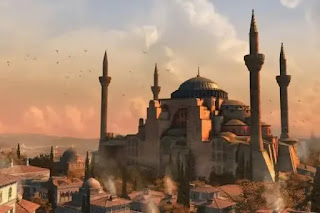Discuss Yeats’ treatment of the Byzantium myth in his Byzantium
Byzantium explores the antithesis of time and eternity. Byzantium was the name of the capital of the Eastern wing of the Holy Roman Empire. It was famous for its mosaic work and gold enamelling. It was a reputed centre of art and culture, but in this poem, Byzantium is portrayed as a “country of the mind”, a transcendental place outside time and space. It is beyond the world of teeming millions. It is a presentation of an ideal state beyond life. It is a contemplation of death rather than the ideal state of death.
The poem opens with a description of Byzantium, its drunken soldiery, its blood and mire, and the peace which apparently descends upon the scene at night. In the second stanza, the poet deals with the process of purification. He evokes the past and the dead. The peace at nightfall is deceptive, for the sounding of the gong is a summons to the spirits of the dead to come out of their graves.
The noises and images peculiar to the night in the great city, such as the song of night-walkers and brawl of the revellers have also melted in the calm atmosphere The poet now faces to face with the great Dome of St Sophia, which suddenly assumes the aspect of the sky, bedecked with the light of the moon and stars and looking down upon the human life on earth with multiplicities, love and hate, grief and confusion, peculiar to the every-day life of men and women
The poet sees an image moving before him, but he is not sure, whether it is a man or a ghost. This very indefiniteness intensifies the atmosphere of mystery The entire place seems to be possessed by spirits. The souls unwind the memories of their earthly existence. They seek purification through suffering. As life and death are the two of the same truth, the human and the superhuman are also closely interlinked. The golden bird is immortal. It has the eternity and purity of art. It disdains the human complexities of blood and mire. The purity of art and its eternity is contrasted with the impure “unpurged” human condition and its transience.
The fourth stanza unrolls the spectacle of purgatory, where the souls are flitting about like flames of fire, which is unearthly. It is the unearthly fire of purgatory which no storm can disturb and which purges the soul into the likeness of flame It is a purgatorial fire, it is a dance of agony they dance, and in this way, the spirits seek purification from all complexity and fury through self expiation
The last stanza of the poem begins with a good deal of excitement and tension. The poet stands near the seashore in Byzantium with his eyes fixed on a large number of dead people coming from distant places, sitting astride on the back of Dolphins across the tumultuous sea. According to Greek mythology, Dolphin was sacred to Aphrodite, the goddess of beauty and love, and to Poseidon, the king of the sea, and was the symbol of speed. The animal is a saviour of human beings and carries them back across the sea to Byzantium. But being sacred to the goddess of love and beauty as aforesaid, it is also loving: animal. It is also an emblem of the dual nature of love, a bridge between the two worlds. The sea is all tumult but it is checked and controlled by the smithies of the emperor. Thus the superiority of art over nature is emphasised. Similarly, “furies of complexity” in the souls of the dead are controlled by their dance of purification of the marble pavements of Byzantium.
The function of the art is to bring about a fusion of the physical with the ideal. The poet may attempt to rise above the ocean of passion and desire but the ocean remains, tom by sexual desire and tormented with the passion of religion, dolphin and gong tormented. Thus the poem emphasises the need for suffering and purification and a sense of the surpassing superiority of art in which the poet seeks anchorage.
The poem is about art, about the relations of art and life. Byzantium itself is the ideal place of calm and quiet atmosphere where the mind can work undisturbed. The poet in the process of uncertainty is in a state of frenzied ecstasy of joy, the highest state of his living. Imagination purifies the soul. It makes the poet immortal and transports him to heaven, a state of perfect bliss. The poet attains perfect bliss while he is absorbed in the business of composing the poem. The poet and the poem merge into each other and become one. He is both dead and living then. He is dead to the world around him, being wholly absorbed in the act of creation. He is life-in-death and death-in-life. As soon as the human soul is purified, it becomes a golden bird that sings. It scorns all that enters into the making of an individuals human. The act of the goldsmith is everlasting. It is a symbol of permanence. The masaies signify spiritual experience. The golden bird represents the liberated soul.
Byzantium is a poem of outstanding merit. Its technique, structure and images are unique. In this poem, both the theme and its treatment are accorded equal status. They are in a happy union. The poem is rich in symbols and full of images. The symbols and images represent the summit of Byzantium’s achievement in art. The symbols are complex, colourful and strifling. The patterns of symbolic meaning in the poem are rich and rewarding. The symbols and images have the character of universality which makes the poem impressive. The poem, therefore, is naturally an improvement upon the earlier composition, Sailing to Byzantium.
